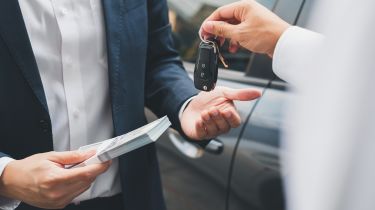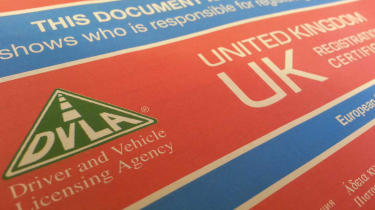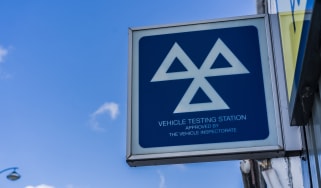How to transfer car ownership: what to do when buying or selling
Ensuring a car safely and legally changes hands can be a daunting task. Here’s everything you need to know to transfer a vehicle’s ownership to another person

When buying or selling a car, there’s more to the process than simply agreeing on a price and handing over the keys. Whether you’re getting rid of your old car or taking another individual's car off of their hands, you need to transfer the car's ownership by informing the DVLA.
Transferring a car's ownership might sound like a daunting process, but thankfully it’s fairly straightforward. You can transfer a car's ownership either online, or the old-fashioned way by filling out the relevant sections in the vehicle's V5C logbook and popping it in the post. Either way, it's important to make sure this is done correctly and on time.
In this handy guide, we’ve set out the necessary steps for ensuring your car changes hands smoothly and safely, whether you’re buying or selling.
Car owner vs registered keeper
Before we go any further, we need to clarify the difference between a car’s owner and the registered keeper.
To keep things simple, the registered keeper is the person who ‘keeps’ the car, uses it day-to-day and is named on the V5C logbook.
It is the registered keeper’s legal responsibility to make sure the car is taxed and insured, and they would be the first point of contact for dealing with issues such as parking or speeding tickets, even if they were not driving the car at the time.
The V5C is not proof of ownership; it only shows who is the registered keeper - although the registered keeper can also be the car's owner.
A car may be owned by a third-party such as a finance company, another business or fleet operator.
You can find out more about the differences between a car's registered keeper and its owner here...

How to transfer ownership when selling a car
Transferring car ownership is a fairly straightforward process and can be completed in three simple steps.
Locate the car’s V5C logbook
Before you list your car for sale or drive down to your local dealer, we’d recommend you dig out your car’s V5C.
All cars registered in the UK have a V5C, this is often known as the vehicle logbook or V5. This document shows who the registered keeper of a car is, although it should be noted that it is not proof of ownership.
If you have lost or misplaced your car's V5C, you can apply for a new one through the government website. To do so, you’ll need:
- The vehicle’s registration number
- The car’s VIN number
- Name and home postcode of the registered keeper
If no information needs changing from the original V5C, then you’ll have to pay a fee of £25 and it should take five working days to arrive.
If you need to change your details, you will need to download and fill in a V62 form and apply for a vehicle registration certificate (V5C). This application can only be made by post.
Fill in the relevant sections in the V5C
When selling or transferring ownership of a car privately, you must fill out section 2 (V5C/2) of the V5 and enter the new owner’s name and address.
You must then tear out and fill in section 6 (V5C/6) and hand it to the new owner. This is the new keeper slip.
The remainder of the V5C, including the newly filled out section 2 (V5C/2), must then be sent to the DVLA.
Inform the DVLA that you’re transferring ownership
There are a few different ways you can tell the DVLA you’re transferring ownership
Transfer car ownership online
The easiest way of transferring the ownership of a car is by filling out a form on the DVLA website.
You’ll need the details of the new owner and the 11-digit reference number from the car’s V5C. Once the form has been completed and submitted, the DVLA will send you a confirmation email of the transfer of ownership. A follow-up letter will also be sent in the post.
A new V5C logbook will be issued automatically to the new owner in around five working days. The old V5C is no longer required and can be disposed of.
Transfer car ownership by post
You can also inform the DVLA and transfer a car’s ownership by post, although this process can be slow.
You’ll need to fill out section 2 with the new keeper’s details, and fill out section 6 (V5C/6), including the date of sale. Tear off section 6 and hand this to the new keeper.
You then need to send the V5C to the DVLA at:
DVLA,
Swansea,
SA99 1BA.
Once you've sold the vehicle, you'll get a tax rebate on any outstanding VED (Vehicle Excise Duty) road tax that you may have paid for that year. That's because, under the current VED system, road tax is no longer transferable with the vehicle.
If you pay your VED road tax by direct debit, this will also be cancelled once you receive confirmation from the DVLA that ownership has been transferred.

How to transfer ownership when selling a car to a dealership or scrapyard
When selling a car to a dealership or scrapyard, the process of transferring ownership is similar to selling a car privately.
However, rather than filling out section 6 as you would for a private sale, you fill out section 4 with the dealer’s or scrapyard’s details.
If your V5C was issued before April 2019, you’ll also need to fill out section 9. Once completed, separate this section from the rest of the V5C and send this to the DVLA. The remainder of the V5C can be handed to the dealer.
How to transfer ownership when buying a car
If you’re buying a car and the seller intends to update the information online, then make sure you give them your email address. The seller can then enter this online when making the declaration to the DVLA that you are the new keeper and you will also receive email confirmation that the information has been processed by the DVLA. Whether you provide an email address to the seller or not – it’s not compulsory – a new V5C certificate should arrive through your letterbox within five working days.
Remember too that the car's road tax doesn't transfer when you buy a vehicle. You must pay road tax or declare SORN (statutory off-road notice) immediately when your new V5C arrives.
What happens if you fail to notify the DVLA?
When a car is sold, scrapped or written off, the registered keeper is legally required to inform the DVLA. Failure to do so could result in an out of court settlement letter (OCS) being issued. The penalty in an OCS letter is set at £55, reduced to £35 if paid within 17 days.
If the fine is not paid, the case may be pursued through the magistrates’ court, with a maximum penalty of up to £1,000.
Did you know you can buy a used car with Auto Express? Choose from tens of thousands of cars with trusted dealers around the UK. Click here to buy used with Auto Express now...
Find a car with the experts







